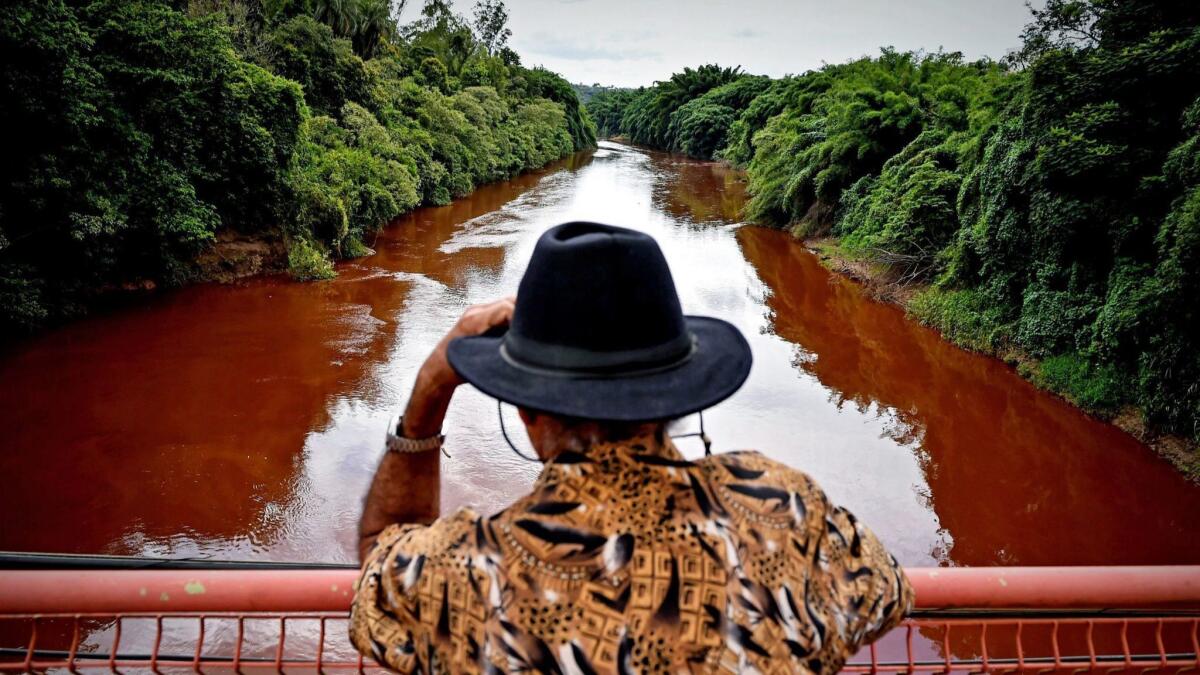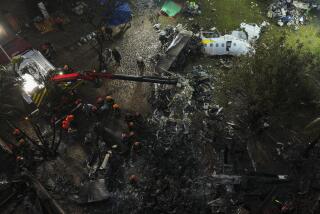A year ago, a Brazilian mining dam burst, forever burying a town. Now executives face homicide charges

- Share via
Exactly one year ago Saturday, a Brazilian dam operated by iron ore miner Vale gave way to a tsunami of 9.7 million cubic meters of mining sludge that buried part of a town and killed 270 people.
In the days, weeks and months since Jan. 25, 2019, the world’s largest iron ore miner has made progress in undoing some — but not all — of the damage done when the dam burst.
Its chief executive stepped down. (He was charged with homicide this week by local prosecutors.) Vale’s stock price has recovered, and output is on its way back.
But the community that was unmade when the structure fell will never truly be remade.
People who were in the city of Brumadinho on the day of the disaster, and those who have visited since, struggle to find words to describe the devastation in a way the outside world can grasp. It is, even to those who lived through the tragedy, beyond understanding.
Gone is the constant whoosh of helicopters overhead that spirited out the dead on dangling stretchers. In its place is the sound of hundreds of bulldozers and trucks.
Though the surrounding community will never be rebuilt, Vale is on the hook for at least cleaning up the sludge laced with iron ore residue and mining waste so that it doesn’t further pollute Brumadinho water supplies. It is laborious work that requires draining the water from the mud, packing the dirt down into bricks, piling them up in the countryside and covering them up with replanted vegetation.
Local firefighters still scour the mud at Brumadinho. Each day, the hunt for the missing goes on. And each day, more often than not, body parts are all they can find.
In the days after the dam collapse, the mud was so wet in some areas that body-sniffing rescue dogs couldn’t catch scents. A team of 150 rescuers crawled through the wreckage and searched the sludge with their hands.
So far, 259 bodies have been identified through DNA sampling; around Christmas, two more bodies were found. Eleven people are still missing, and the 90 firefighters that remain say they won’t give up until they find them. They use excavators now to dig, watching closely as the dirt falls to the ground for any signs of the dead.
“We haven’t stopped for a single day, not even on Christmas, and we don’t plan to,” Lt. Douglas Constantino says. “Those families need closure.”

Zeca Goncalves was finishing lunch when he heard what sounded like an explosion. He rushed out of his hilltop home to find that a wall of mud had buried part of the city where he was born.
The 68-year-old retired bricklayer looked toward a bed and breakfast at which two cousins and two nephews worked, but he could no longer see it. A neighbor’s house, some 20 meters away from his own, was also destroyed.
“I just stood there and stared at it for some 15 minutes. I went completely dumbfounded,” he said. “I went home to tell my wife, but she didn’t believe me. So I came back out and stared for hours more.”
Just about everyone in the mining town knew someone — most likely more than one — who died that day. Goncalves’ four relatives, along with several friends, were among them.
Many of the people who remained took the cash payouts Vale offered, packed up and moved away. Direct family members got at least 700,000 reais (about $170,000), while others such as Goncalves received 50,000 reais, plus small monthly payouts.
Goncalves can point out four or five houses on his street in the Corrego do Feijao neighborhood that now stand empty. He said he plans to stay put and has used the money to buy a car. “This used to be the best place ever,” he recalled.
People across Minas Gerais state are still furious at Vale over the disaster. Fabio Schvartsman, who was the company’s CEO at the time, was charged this week with 270 counts of homicide, while Vale and a contractor, Tuv Sud, were accused of environmental crimes. State prosecutors allege that the 65-year-old executive knew about the risks but made false statements and hid information to protect the company’s share price.
“They turned a blind eye,” Prosecutor General Antonio Sergio Tonet told reporters. Their negligence, another official added, caused “the dam to break with the strength of a tsunami that destroyed everything in its way.”
Schvartsman took over in 2017, a little less than two years after the Mariana tailings dam collapsed in a separate incident, killing 19. “He entered the role with the slogan ‘Mariana Never Again,’ but it was a false slogan,” William Coelho, a state prosecutor, told reporters in Minas Gerais.
Globally, it’s rare that a top executive would be charged with homicide because of corporate actions — though not totally unheard of. The head of Union Carbide Corp. was charged with manslaughter by Indian authorities for a 1984 gas leak that killed thousands in Bhopal (he was arrested but never faced trial after the U.S. refused to extradite him). The CEO of ThyssenKrupp’s Italian unit was sentenced to prison after a fire at a steel plant there killed seven workers in 2007; and the CEO of a South Korean ferry company was charged with homicide through occupational negligence after hundreds died when his vessel sank in 2014.
Schvartsman ranks as the highest-profile executive yet to face charges after the January 2019 disaster. He took a leave from his post in March after federal prosecutors recommended his immediate exit. Other former employees were also accused of homicide. For the Mariana disaster, prosecutors filed charges against 21 people in 2016.
In certain pockets around Brazil, people still ask themselves: Could we be next?
A key factor in the latest disaster was the type of structure Vale used to contain tailings from its upstream mining operations. Mud built up behind a front wall that was 700 meters wide and as tall as a 24-story building. But there was internal erosion, and the dense mud liquefied. Prosecutors say the company intentionally hid signs that the structure was failing. It has been ordered to dismantle at least nine similar dams and reintegrate them back into their environment.
Residents around the riskiest of the dams were relocated to settlements. But others still live nearby, always on alert for the sirens that Vale installed to warn them if it becomes time to flee. All in all, Vale has spent $6.3 billion on provisions and expenses related to Brumadinho.
More to Read
Inside the business of entertainment
The Wide Shot brings you news, analysis and insights on everything from streaming wars to production — and what it all means for the future.
You may occasionally receive promotional content from the Los Angeles Times.










